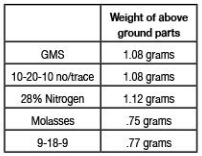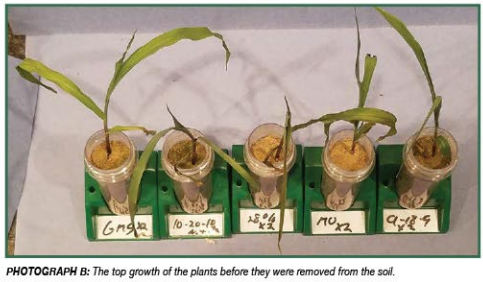Proper Foliar Feeding Practice and Benefits
Each year, we include an article in the early summer Solution with foliar feeding methodology as a reminder/teaching tool for our customers. This year, with our Research Team conducting research into foliar feeding in a lab environment, we would also like to share some information on the effect GMS has on the root zone and soil microbiology, with a potent picture worth a thousand words.
FOLIAR APPLIED GMS IN THE ROOT ZONE
Take a look at Photograph A before reading this section. The plants in the photograph were sprayed twice, four days apart, with a solution of GMS and water equivalent to 2 gallons per acre (per spray), the same solution but with a sample of GMS with no trace elements added to it, 28% nitrogen, molasses, and a 9-18-9 liquid fertilizer. They were also watered only once with pure water, then left to wilt, after which they were plucked, dried, weighed, and the soil tested with the MicroBiometer.
As you can see from the photograph, the roots of the plant sprayed with GMS are significantly heavier than all of the other competitors. Please also note that these plants were growing in dry conditions for most of their short life, meaning that even in drought conditions, fertility sprayed on the foliage is translocated into the root system. Also note Photograph B (below), which shows the top growth of the plants before they were plucked and dried. The chart shows the weights of the above ground portion of the plants after they were plucked and dried, and both GMS products were only beaten by 28% nitrogen. Nitrogen causes lots of top growth, so this shouldn't be too surprising, though I'm willing to bet that, had these plants been allowed to grow further, it wouldn't have held the lead as the plant took advantage of the balance of nutrition in GMS to build more tissue.
WASHING AND MIXING PRECAUTIONS
Since many people's sprayers are used for multiple products, including fertility and various pest and weed control products, it's important to remember to wash out your sprayer of old product before going out to spray GMS. This is for two reasons:
1) Even residual amounts of herbicides, such as that left in the lines or lining the inside of a tank, are strong enough to seriously damage or kill non-resistant crops if accidentally sprayed onto them. This is especially important with newer technologies, including glyphosphate, dicamba, and 2-4D mixtures. Please follow proper tank cleaning protocols in order to avoid crop damage. 2) GMS is unpredictable in how it will react to or affect herbicides when they are mixed. Just as when mixing with some hard water, there may be precipitate that will cause efficiency and equipment problems. Also, some operators have noticed an increase in herbicide potency when mixed with GMS, causing even resistant crops some problems. It is not advisable to tank mix GMS with any other product.
FINE MIST
Foliar feeding with fertility products is most successful when as much of the plant as possible is coated in as fine a mist as possible. The pores in leaves' cuticles are very small and so will absorb small water particles much better than large ones. Spray pressures over 40 psi tends to produce the smallest particles. In addition, if spray drift is a concern, tend towards higher spray pressures for the anti-drift type of nozzle you are using. Remember, plants can absorb nutrition through their leaves and through the smooth bark/stalks, so getting as much coverage as possible is in your best interest.
SPRAY TIMING
Foliar spraying should not be done in the heat of the day or in direct sunlight. This is because foliar nutrition must be absorbed through pores in the leaf surface, which will close in high heat or sunlight to prevent water loss from the plant, thereby preventing them from absorbing anything on their surface. Furthermore, since foliar nutrition must be absorbed with water through the plant surface, we advise that you spray when there is, or will shortly be, dew on it. Taking these together, the best times to spray are early morning, late evening, on overcast or foggy days, or anytime the leaves will have dew on them. If you do spray in high heat or direct sunlight, the risks of leaf burn and bad fertilizer efficiency are high.
SPRAYING GMS STRAIGHT OR DILUTED
GMS can be sprayed straight or be diluted in water. In the early days of the company, when low-volume sprayers were more commonplace, spraying GMS straight was by far the most popular choice. Since the use of foliar applied herbicides and fungicides has become widespread, higher volume sprayers have become more the norm. In such a case, GMS can be mixed with water to meet volume requirements. Spraying straight or diluted does not affect the effectiveness of GMS, barring if water of poor quality is used.
If you are going to mix GMS with water, it is best to use R.O., distilled, or rainwater because they contain little to no dissolved solids. The phosphorus in GMS can react poorly with the various elements in hard water creating a white precipitate that reduces efficiency and can plug up sprayer screens and nozzles. However, if you keep the amount of water added under the amount of GMS, this should not be a problem.
WATER QUALITY CONSIDERATIONS
In the past, we recommended that, if you were going to mix GMS with hard water, you acidify the water first to ensure it wouldn't react with the GMS and produce a precipitate. Acidifying the water will prevent the phosphorus and various elements from bonding together and precipitating out. While this will ensure that the mixture makes it through your screens and nozzles, research done over the past year and a half has shown that even if the water and GMS don't react, there is still a detrimental effect on the leaf from using hard water. The mineral left on the leaf surface from the hard water can impair photosynthetic potential, so it is important to use clean, low dissolved solid water to ensure no harm comes to the plant and you get the most out of GMS.
This is an excerpt from the Summer Growers Solution (2022) written by Zach Smith, Product and Training Specialist.
Signup for our newsletter to stay in the loop



